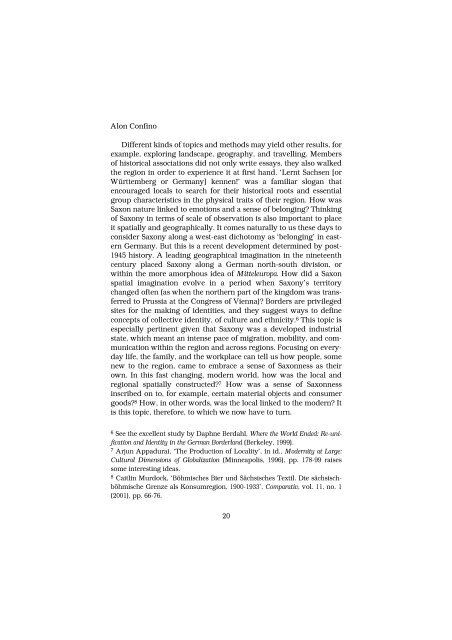Download - German Historical Institute London
Download - German Historical Institute London
Download - German Historical Institute London
You also want an ePaper? Increase the reach of your titles
YUMPU automatically turns print PDFs into web optimized ePapers that Google loves.
Alon Confino<br />
Different kinds of topics and methods may yield other results, for<br />
example, exploring landscape, geography, and travelling. Members<br />
of historical associations did not only write essays, they also walked<br />
the region in order to experience it at first hand. ‘Lernt Sachsen [or<br />
Württemberg or <strong>German</strong>y] kennen!’ was a familiar slogan that<br />
encouraged locals to search for their historical roots and essential<br />
group characteristics in the physical traits of their region. How was<br />
Saxon nature linked to emotions and a sense of belonging? Thinking<br />
of Saxony in terms of scale of observation is also important to place<br />
it spatially and geographically. It comes naturally to us these days to<br />
consider Saxony along a west-east dichotomy as ‘belonging’ in eastern<br />
<strong>German</strong>y. But this is a recent development determined by post-<br />
1945 history. A leading geographical imagination in the nineteenth<br />
century placed Saxony along a <strong>German</strong> north-south division, or<br />
within the more amorphous idea of Mitteleuropa. How did a Saxon<br />
spatial imagination evolve in a period when Saxony’s territory<br />
changed often (as when the northern part of the kingdom was transferred<br />
to Prussia at the Congress of Vienna)? Borders are privileged<br />
sites for the making of identities, and they suggest ways to define<br />
concepts of collective identity, of culture and ethnicity. 6 This topic is<br />
especially pertinent given that Saxony was a developed industrial<br />
state, which meant an intense pace of migration, mobility, and communication<br />
within the region and across regions. Focusing on everyday<br />
life, the family, and the workplace can tell us how people, some<br />
new to the region, came to embrace a sense of Saxonness as their<br />
own. In this fast changing, modern world, how was the local and<br />
regional spatially constructed? 7 How was a sense of Saxonness<br />
inscribed on to, for example, certain material objects and consumer<br />
goods? 8 How, in other words, was the local linked to the modern? It<br />
is this topic, therefore, to which we now have to turn.<br />
6 See the excellent study by Daphne Berdahl, Where the World Ended: Re-unification<br />
and Identity in the <strong>German</strong> Borderland (Berkeley, 1999).<br />
7 Arjun Appadurai, ‘The Production of Locality’, in id., Modernity at Large:<br />
Cultural Dimensions of Globalization (Minneapolis, 1996), pp. 178-99 raises<br />
some interesting ideas.<br />
8 Caitlin Murdock, ‘Böhmisches Bier und Sächsisches Textil. Die sächsischböhmische<br />
Grenze als Konsumregion, 1900-1933’, Comparativ, vol. 11, no. 1<br />
(2001), pp. 66-76.<br />
20













